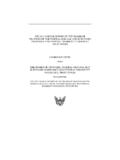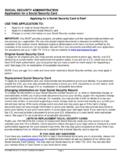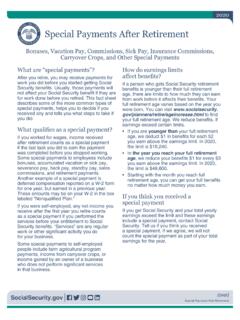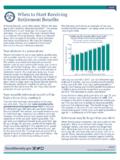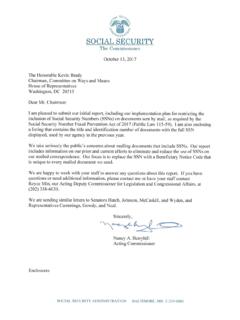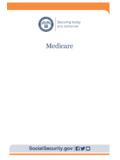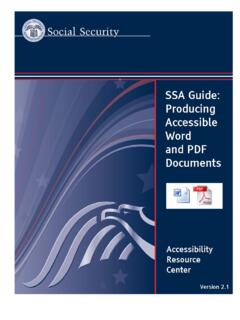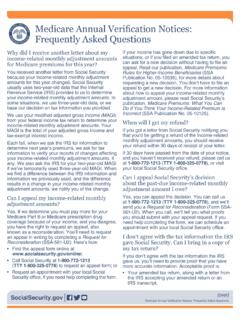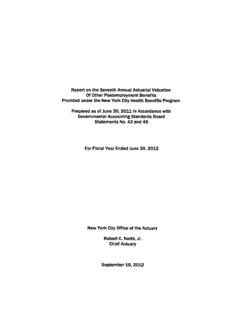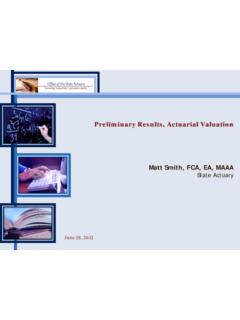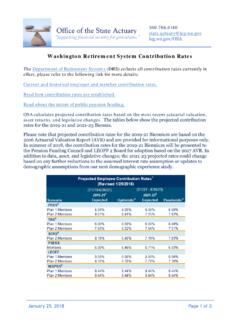Transcription of SOCIAL SECURITY
1 SOCIAL SECURITY administration BALTIMORE, MD 21235-0001 SOCIAL SECURITY office of the Chief actuary December 8, 2016 The Honorable Sam Johnson Subcommittee on SOCIAL SECURITY Committee on Ways and Means United States House of Representatives Washington, 20515 Dear Chairman Johnson: I am writing in response to your request for estimates of the financial effects on SOCIAL SECURITY of 6489, the SOCIAL SECURITY Reform Act of 2016, which you introduced today. The estimates provided here reflect the intermediate assumptions of the 2016 Trustees Report. This Bill (hereafter referred to as the proposal) includes fifteen provisions with direct effects on the SOCIAL SECURITY Trust Funds. The estimates and analysis provided here reflect the combined effort of many in the office of the Chief actuary , but most particularly Karen Glenn, Christopher Chaplain, Daniel Nickerson, Kyle Burkhalter, Michael Clingman, Anna Kirjusina, Katie Sutton, and Tiffany Bosley.
2 The enclosed tables provide estimates of the effects of the fifteen provisions on the cost, income, and combined trust fund reserves for the Old Age, Survivors, and Disability Insurance (OASDI) program, as well as estimated effects on retired worker benefit levels for selected hypothetical workers. In addition, tables 1b and provide estimates of the federal budget implications of the fifteen provisions. Assuming enactment of the plan, we estimate that the combined OASI and DI Trust Funds would be fully solvent (able to pay all scheduled benefits in full on a timely basis) throughout the 75-year projection period, under the intermediate assumptions of the 2016 Trustees Report. In addition, under this plan the OASDI program would meet the further conditions for sustainable solvency, because projected combined trust fund reserves would be growing as a percentage of the annual cost of the program at the end of the long-range period.
3 While we estimate that the provisions of this proposal would make the combined OASI and DI Trust Funds solvent throughout the 75-year projection period under the intermediate assumptions of the 2016 Trustees Report, the two trust funds are separate legal entities. Some modification of the allocation of the total payroll tax rate between the OASI Trust Fund and the DI Trust Fund might be necessary to ensure that both trust funds would remain solvent for the next 75 years under these assumptions. The proposal includes fifteen basic provisions with direct effects on the OASDI program. The following list briefly identifies each provision: Page 2 The Honorable Sam Johnson 1) For retired worker and disabled worker beneficiaries becoming initially eligible in January 2023 or later, phase in a new benefit formula (from 2023 to 2032).
4 Replace the existing two PIA bend points with three new bend points and modified benefit formula factors. 2) Use an annualized mini-PIA formula beginning with retired and disabled worker beneficiaries becoming newly eligible in 2023, phased in over 10 years. The mini-PIA calculation would use a single year s average monthly indexed earnings (mini-AIME) and primary insurance amount (mini-PIA) for each year with taxable earnings. 3) Replace the current-law Windfall Elimination Provision (WEP) with a new calculation for most OASI and DI benefits based on covered and non-covered earnings, phased in for beneficiaries becoming newly eligible in 2023 through 2032. 4) After the normal retirement age (NRA) reaches 67 for those attaining age 62 in 2022, increase the NRA by 3 months per year starting for those attaining age 62 in 2023 until it reaches 69 for those attaining age 62 in 2030.
5 Increase the age up to which delayed retirement credits may be earned from 70 to 72 on the same schedule. 5) Beginning with the December 2018 COLA, provide no COLA for those with modified adjusted gross income (MAGI) above specific thresholds and compute the COLA using the chain-weighted version of the CPI-U (C-CPI-U) for all other beneficiaries. 6) For spouses and children of retired workers and disabled workers becoming newly eligible beginning in 2023 and phased in for 2023 through 2032, limit their auxiliary benefit to the amount based on one-half of the PIA of a hypothetical worker with earnings equal to the national average wage index (AWI) each year up to his or her eligibility year, and who has the same eligibility year as the worker.
6 7) Beginning in January 2019, require full time school enrollment as a condition of eligibility for child benefits at age 15 up to 18. 8) Provide a new minimum benefit for workers with more than 10 years of covered earnings above a specified level, phased in for retired and disabled worker beneficiaries becoming newly eligible in 2023 through 2032. 9) Beginning in January 2019, eliminate the retirement earnings test for all beneficiaries under NRA. 10) Eliminate federal income taxation of OASDI benefits that is credited to the OASI and DI Trust Funds for 2054 and later, phased in from 2045 to 2053. 11) Provide an option to split the 8-percent delayed retirement credit (DRC) to offer a lump sum benefit at initial entitlement equivalent to 2 of the 8 percent DRC earned, and a 6 percent DRC on subsequent monthly benefits, effective for workers attaining age 62 in 2023 and later.
7 Page 3 The Honorable Sam Johnson 12) Beginning in January 2023, provide an addition to monthly benefits for all beneficiaries who have been eligible for at least 20 years. The additional amount is calculated based on 5 percent of the PIA for a hypothetical worker with earnings equal to the national average wage index each year. 13) Beginning in January 2023, for new and current disabled widow(er) beneficiaries, change the requirement that disability must occur no later than 7 years after the worker s death, or after surviving spouse with child-in-care benefits were last payable, to no later than 10 years. 14) Beginning in January 2023, for new and current disabled surviving spouse beneficiaries, eliminate the requirement to be age 50 or older for receipt of benefits.
8 15) Beginning in January 2023, for new and current beneficiaries, waive the two-year duration of divorce requirement for divorced spouse benefit eligibility in cases where the worker (former spouse) remarries someone other than the claimant before the two-year period has elapsed. The balance of this letter provides a summary of the effects of the fifteen provisions on the actuarial status of the OASDI program, our understanding of the specifications and intent of each of the fifteen provisions, and descriptions of our detailed financial estimates for trust fund operations, benefit levels, and implications for the federal budget. See the Specification for Provisions of the Proposal section of this letter for a more detailed description of these fifteen provisions.
9 Summary of Effects of the Proposal on OASDI Actuarial Status Figure 1 illustrates the projected trust fund ratio through 2090 under present law and assuming enactment of the proposal. The trust fund ratio is defined as the combined Old-Age and Survivors Insurance (OASI) and Disability Insurance (DI) Trust Fund reserves expressed as a percent of annual program cost. Assuming enactment of the proposal, the combined OASI and DI Trust Funds would be fully solvent throughout the 75-year projection period, under the intermediate assumptions of the 2016 Trustees Report. In addition, because the projected trust fund ratio is increasing at the end of the period, the plan meets the conditions for sustainable solvency. It should be noted, however, that because the projected level of reserves reaches as low as 10 percent of annual program cost around 2045, unexpected fluctuations in the economy or other factors affecting program cost or revenue could require additional temporary measures to maintain solvency through this period.
10 Page 4 The Honorable Sam Johnson Note: Trust Fund Ratio for a given year is the ratio of reserves in the combined OASI and DI Trust Funds at the beginning of the year to the cost of the program for the year. Under current law, 79 percent of scheduled benefits are projected to be payable on a timely basis in 2034 after depletion of the combined trust fund reserves, with the percentage payable declining to 74 percent for 2090. Under the plan, the OASDI program would be solvent throughout the 75-year projection period, and would have the ability to pay 100 percent of scheduled benefits on a timely basis for the foreseeable future. Enactment of the fifteen provisions of this proposal would change the long-range OASDI actuarial deficit from percent of taxable payroll under current law to a positive actuarial balance of percent of payroll under the proposal.
